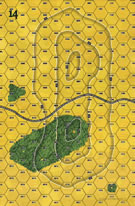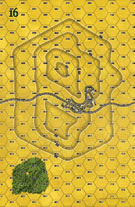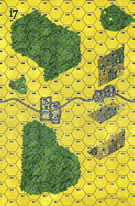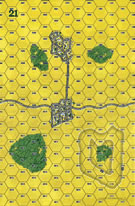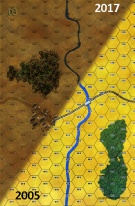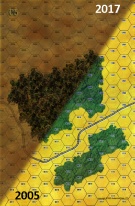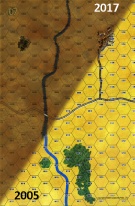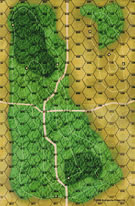|
Training and Doctrine Iron Curtain #9 |
||
|---|---|---|
| (Defender) United States | vs | Soviet Union (Attacker) |
| Formations Involved | ||
|---|---|---|
| Soviet Union |  |
12th Guards "Umanskaya" Tank Division |
| United States |  |
101st "Screaming Eagles" Airborne Division |
| United States |  |
807th Tank Destroyer Battalion |
| United States |  |
813th Tank Destroyer Battalion |

|
| Overall Rating, 1 vote |
|---|
|
4
|
| Scenario Rank: --- of 940 |
| Parent Game | Iron Curtain |
|---|---|
| Historicity | Alt-History |
| Date | 1948-08-02 |
| Start Time | 06:00 |
| Turn Count | 48 |
| Visibility | Day |
| Counters | 208 |
| Net Morale | 0 |
| Net Initiative | 1 |
| Maps | 8: 14, 16, 17, 21, 3, 6, 7, 9 |
| Layout Dimensions | 112 x 86 cm 44 x 34 in |
| Play Bounty | 228 |
| AAR Bounty | 171 |
| Total Plays | 1 |
| Total AARs | 1 |
| Battle Types |
|---|
| Bridge Control |
| Road Control |
| Rural Assault |
| Urban Assault |
| Conditions |
|---|
| Entrenchments |
| Off-board Artillery |
| Smoke |
| Terrain Mods |
| Scenario Requirements & Playability | |
|---|---|
| Airborne - IE | Counters |
| Battle of the Bulge | Maps + Counters |
| Eastern Front | Maps |
| Iron Curtain | Base Game |
| Road to Berlin | Maps + Counters |
| Introduction |
|---|
|
American forces fought few of the huge tank battles seen on the Eastern Front or in the Western Desert, and those in charge of the Armored Force considered this a sign of great success. The American M4 Sherman was not a match for German battle tanks, nor, according to classroom theory, did it need to be. The job of tanks would be to break through enemy infantry formations and then rapidly exploit the opening. Enemy tanks were to be fought by tank destroyers - a catchall term covering self-propelled guns and towed anti-tank guns. |
| Conclusion |
|---|
|
Though designed as an "assault tank," the American T28 (the test designation of the M28) would have proven much too slow for such employment. But as heavily armored tank destroyer fighting in positional defense, it might have been much more effective. The "Screaming Eagles" of the 101st Airborne were de-activated after World War II, returning as a training unit in 1948 but not becoming a combat division again until 1956. |
| AFV Rules Pertaining to this Scenario's Order of Battle |
|---|
|
| 1 Errata Item | |
|---|---|

|
All Guards T-34/85 tanks should have AT fire values of 7-7. (Shad
on 2010 Dec 15)
|
| Doctrine Prevails over Training | ||||||||||||
|---|---|---|---|---|---|---|---|---|---|---|---|---|
Setup: The Americans spread their forces our pretty evenly throughout the map west of the river, with the main defensive line comprised of the best leaders and the M28 tank destroyers, all within three hexes of the river, so to stop any Soviet crossing along the river. The Soviets maintain three groups, one in the north, one in the center, and one in the south. The center force is half of the force, with the rest of the Soviets split evenly between the two other forces. Play: The Soviets immediately lay down a cover of smoke in the center and south of the map, and begin advancing on these fronts. Within an hour the Soviets having crossed the river and engaged the Americans in the center and the south. The main backbone of the American defense, the M28's, quickly wither under Soviet AT fire, leaving the American infantry venerable to the combined Soviet force. After the Soviets breakthrough the Americans' line, the center force splits into two one heading due west, the second moving northward to join up with the Soviet force moving east in the north to hit the Americans in the northern town. Meanwhile, in the south, the Soviets' south force smashes into the Americans in the woods on Board 6. The second round of assaults go well with the Soviets, reversing their luck, for they had more trouble at the main defenses. The Soviet spend almost four hours dealing with the Americans on Board 6 after the Americans bring up some reinforcements from the rear, and delay the Soviets for fifteen turns. In the north, the Soviets finally clean up the Americans on Board 7, and begin to move eastward. The Soviets' northern forces splits again, one force hitting the two hex town on Board 17, while the second force swings south, but then back north to attack the four hex town from the woods. After another round of fierce assaults, the Soviets have cleared four boards of American units. However, with only four turns left, the Soviets decline to attack the final two boards. Result: Soviet Major Victory. The Victory Point Count stands at 114-179, with the Soviets having a lead of sixty-five. |
||||||||||||
| 0 Comments |

 IrCu008
IrCu008 



